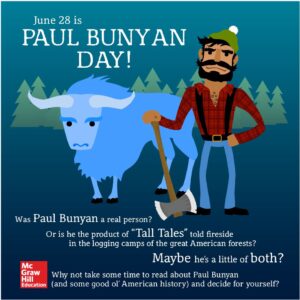

Summer is a time for festivals all over the country. Many are annual events created around a symbol native to the area – a flourishing crop, historical event, or, in the case of Akeley Minnesota, famous folklore heroes. Paul Bunyan Days, held this year from June 27-29, celebrates the heroic lumberjack who became the subject of many “tall tales” (stories deliberately exaggerated for effect) and passed down through generations of loggers.
To celebrate Bunyan’s many great deeds, the town of Akeley (with a population of approximately 432) hosts one of the biggest celebrations of the hero in the world. Established in 1955, the event includes a look alike contest, art show, fish fry, Little Miss pageant, turtle races and a Grand Parade. At the heart of it all is the town’s 25-foot tall statue.
Who Was Paul Bunyan?
Dating back to as early as 1837, the legend goes that it took five storks to deliver a giant newborn Bunyan to his parents. When he clapped and laughed windows broke. As an adult he helped loggers in the Midwest with an uncanny ability to clear trees. He rescued a giant ox (who he named Babe) from a snow bank during the worst blizzard ever. The two became best friends and traveled the country together. In folklore,the footsteps they left behind in Minnesota became the “land of 10,000 lakes,” and their roughhousing formed the Grand Teton mountain range. The Grand Canyon is said to have been made from Bunyan dragging his axe behind him and the Great Lakes formed so that Babe could have a place to drink.
The tales were told for nearly thirty years before someone (a Northern Michigan journalist named James MacGillivray) published them in 1906. Ever since, there have been many adaptations, including a Disney version in 1958.
Death of the Modern Myth?
While the act of passing on stories is probably as old as mankind itself, American folklore became popular during the time of the Revolutionary War and appeared in newspapers in the early 1800s. As pioneers traveled West, the early settlers entertained one another with tales of great heroism, a trait that became a deeply American characteristic. Some of the most popular involved real life people like Davy Crocket, Pecos Bill and Johnny Appleseed. Children’s books became very popular in the 1930s and many tall tales were adapted into this format.
Popularity of the tall tale began to diminish in the mid-twentieth century. Perhaps this is due to the popularity of television and other popular art forms. Or maybe people are less gullible because there are many more resources to explain (or disprove) phenomenon. Despite the apparent lack of modern day myths, the appeal of the classic tall tale continues to endure.
